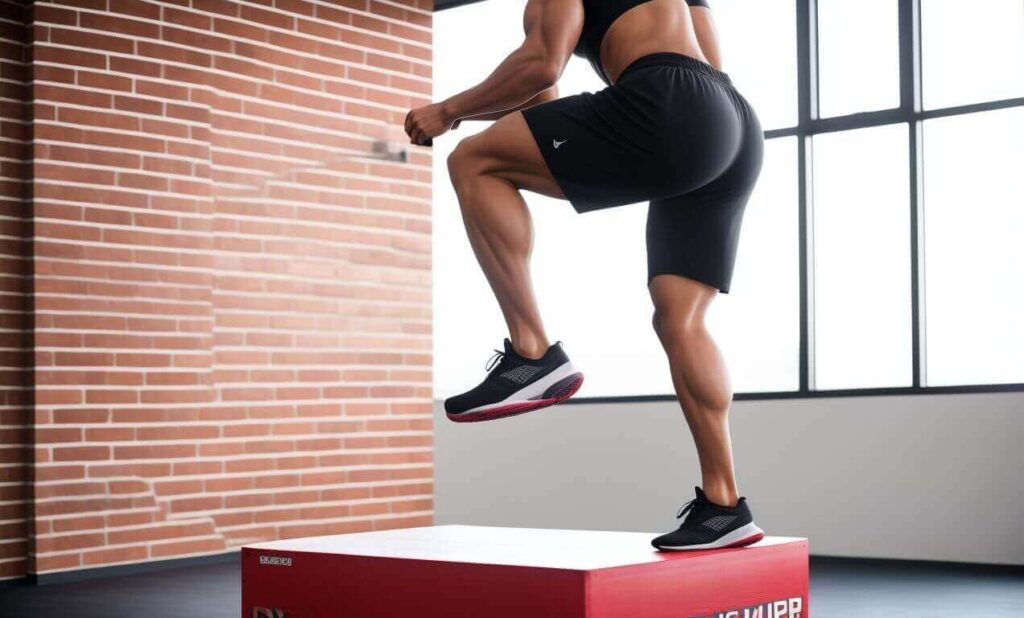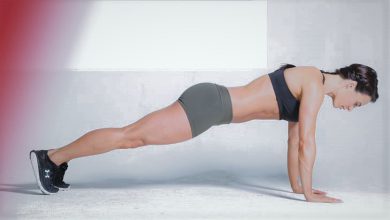Are you looking for a way to take your strength training to the next level? If so, incorporating plyometrics into your workout routine may be what you need. Plyometrics, also known as jump training, is a form of exercise that involves explosive movements designed to increase power, speed, and overall athletic performance.
By incorporating plyometrics into strength training, you can create a comprehensive workout program that targets both your muscular and cardiovascular systems. We’ll explore the benefits of plyometrics, and how to incorporate them into your strength training routine.
Table of Contents
What is Plyometric Training?
Plyometric training, also known as jump training or plyos, is a type of exercise that involves explosive movements designed to increase muscular power, speed, and agility. It typically consists of jumping or hopping exercises, such as box jumps, depth jumps, or bounding drills. Plyometric training is often used by athletes in sports that require quick bursts of power, such as basketball, football, or track and field.
This training method capitalizes on the stretch-shortening cycle, utilizing the elastic properties of muscles and tendons to produce powerful movements. By performing exercises such as box jumps, depth jumps, and medicine ball throws, athletes can improve their speed, agility, and vertical jump height.
What Are the 3 Phases of the Stretch-Shortening Cycle?
Stretch-shortening-cycle (SSC) happens when an active muscle lengthening is immediately followed by active muscle shortening. There are three phases in this process, namely eccentric, amortization, and concentric phases. Amortization, which is also called load, is the characteristic of plyometrics. It’s an extremely short break during which you can use the stored energy.
If this break takes longer than 25 milliseconds, you lose that stored energy in the form of heat. After the load phase, your body unleashes that energy during the concentric phase of the stretch-shortening cycle.
Can Plyometrics Be Incorporated into Strength Training?
Yes, we can incorporating plyometrics into strength training. In fact, combining the two types of training can be a great way to improve your overall fitness and athletic performance. This combination is an effective way to improve power and explosiveness.
One common approach is to integrate plyometric exercises as a form of “power training” within a strength training workout. For example, after performing a traditional strength exercise, such as a squat or deadlift, you could follow it up with a plyometric exercise, such as box jumps or jump squats. This can help develop the fast-twitch muscle fibers that are important for explosive movements like jumping, sprinting, and throwing.
A study was conducted on a group of male basketball players. The experiment involved a 7-week traditional strength training program combined with specific plyometrics. The study concluded that combination of strength training and plyometrics increased strength, improved performance, and also reduced body fat.
Another study aimed at determining the effect of plyometric push-up on bench press performance. Two groups of resistance-trained male athletes performed plyometric push-up in three sets of five repetitions. Afterward, the participants performed bench press in three sets of three repetitions with 70%1RM. The study showed that plyometric push-up led to the enhancement of bench-press performance in participants.
Plyometric Training for Performance Enhancement

Performance enhancement involves improving various physical attributes and skills to optimize athletic performance. This can include increasing strength, power, speed, agility, vertical jump height, and overall athletic capabilities. The goal is to enhance an individual’s ability to perform specific movements and tasks associated with their sport or activity.
Plyometric training plays a crucial role in performance enhancement by targeting specific physiological mechanisms and movement patterns. Here’s how plyometric training helps improve performance:
- Explosive Power Development: Plyometric exercises require rapid stretching and contracting of muscles, which enhances the neuromuscular system’s ability to generate explosive power. This translates to improved speed, quickness, and explosive movements required in many sports.
- Enhanced Muscular Strength: Plyometric training involves high-intensity exercises that engage multiple muscle groups simultaneously. This leads to increased muscular strength and endurance, allowing athletes to perform at higher intensities for longer durations.
- Improved Rate of Force Development: Plyometrics trains the body to produce force rapidly, enhancing the rate of force development (RFD). This is crucial for activities that demand quick and powerful movements, such as sprinting, jumping, and change of direction.
- Neuromuscular Coordination: Plyometric training enhances the coordination between the nervous system and muscles, improving motor unit recruitment and synchronization. This improved coordination translates to better movement efficiency and control during athletic tasks and even everyday life.
- Increased Elastic Energy Utilization: Plyometrics capitalizes on the stretch-shortening cycle, using the stored energy in muscles during rapid eccentric contractions. This energy transfer enhances the efficiency and power output of subsequent concentric contractions, leading to improved athletic performance.
If the delay between eccentric and concentric phases of plyometric moves is too long, the elastic energy will dissipate. Using this stored energy during the braking phase generates more power in the concentric phase. Due to this phenomenon, when a plyometric athlete drops off an elevated level, they jump higher after bouncing off the floor.
Besides, a study on medical faculty students found that plyometrics training can improve short-term memory and mood.
By incorporating plyometric exercises into strength training program, athletes can enhance their performance by improving power output, strength, speed, agility, and overall athletic capabilities. Plyometric training should be gradually progressed and tailored to individual needs and abilities to ensure safety and maximize benefits. Consulting with a qualified strength and conditioning professional is recommended to design an effective plyometric training program.
Does Plyometric Training Build Muscle?
While plyometric training may not be the primary method for muscle hypertrophy, it can still contribute to muscle development. Plyometric training involves rapid stretching and contracting of muscles, exploiting the stretch-shortening cycle to generate maximal force output. This high-intensity form of exercise primarily targets the fast-twitch muscle fibers, which have greater potential for hypertrophy—the process of muscle growth—compared to slow-twitch fibers.
By targeting fast-twitch fibers and using eccentric loading, plyometrics can stimulate muscle growth to a certain extent. For optimal results, it is recommended to incorporate plyometric exercises alongside a well-rounded resistance training program that includes adequate volume, intensity, and progression.
Related: Learn about hypertrophy sets and reps in Best sets for bodyweight hypertrophy.
Combining Plyometrics and Calisthenics

Let’s have a realistic look at calisthenics. In bodyweight exercises, we are after utilizing our own body and reduce, if not eliminate, dependency to equipment. Nevertheless, at one point, we will reach the limit of our body weight. The very nature of calisthenics drives us towards engaging various techniques and training modalities instead of using weights.
Plyometrics is one of those training modalities that brings new values to our training routine and requires no extra equipment. Combining calisthenics with plyometric exercises creates a potent training stimulus, challenging the body in multiple planes of motion and improving overall athletic performance.
When plyometrics and calisthenics are combined, several benefits emerge:
- Enhanced Power and Strength without using weights.
- Movement Efficiency: Improves neuromuscular coordination, body control, and movement efficiency, leading to enhanced athletic performance and agility.
- Functional Strength: by integrating plyometrics, which mimics dynamic movements involved in various sports and activities, individuals develop strength that translates directly to their specific athletic endeavors.
- Versatility and Accessibility: Both plyometrics and calisthenics can be performed with minimal equipment and in various settings, making them accessible to a wide range of individuals. The ability to perform these exercises anywhere, anytime, adds to their practicality and versatility.
It is worth noting that proper form, technique, and safety considerations should always be prioritized during plyometric and calisthenics training. Adequate warm-up, gradual progression, and listening to the body’s signals are essential to prevent injuries and optimize results. Plyometric exercise is less controlled than traditional resistance training, so the possibility of injury is higher in this system.
Plyometrics TRX Workout
The fusion of plyometric exercises with TRX training can result in a challenging and dynamic workout. A plyometric TRX workout combines the principles of plyometric training, which emphasize explosive movements, with the versatility and suspension training offered by TRX equipment. It is an efficient way of adding plyometrics to strength training in every exercise.
Furthermore, the instability introduced by the TRX straps forces the body to engage additional stabilizer muscles, enhancing overall balance, coordination, and proprioception.
Sample Plyometrics TRX exercises include: TRX squat jumps, single-leg plyometric lunges, TRX burpee, TRX Side-to-Side Jumps, and TRX plyometric push-ups.
When incorporating plyometric movements into a TRX training routine, it is crucial to focus on proper form, adequate warm-up, and gradual progression. Start with foundational exercises and gradually increase the intensity and complexity as strength and skill improve.
Remember to listen to your body, rest appropriately between sets, and consult with a qualified fitness professional to ensure a safe and effective Plyometrics TRX workout routine.
To learn about different types of muscle contractions in TRX read TRX isometric exercises.
Plyometrics Before or After Strength Training?

The order of incorporating plyometrics before or after strength training depends on your specific goals, training program, and personal preferences. Both approaches have their advantages, and the decision ultimately depends on what you prioritize in your training session. In the following circumstances, we can perform plyometrics before strength training:
- Pre-Fatigue: Performing plyometrics before strength training can pre-fatigue your muscles, which may limit your ability to lift heavy weights during strength exercises. This approach is often used when the primary focus is power development and improving explosive performance. By targeting the fast-twitch muscle fibers with plyometrics first, you can maximize their recruitment during subsequent strength exercises.
- Skill and Technique Focus: Performing plyometrics at the beginning of your workout allows you to prioritize and focus on the technical aspects of these exercises. When you’re fresh, you can concentrate on proper form, power generation, and coordination, which are essential for effective plyometric training.
- Safety and Injury Prevention: Plyometric exercises are high-impact and require optimal muscle recruitment and coordination. Fatigued muscles from previous strength training may compromise your form and increase the risk of injury during plyometrics.
Performing plyometrics after strength training may be more suitable under certain conditions:
- Advanced Training Level: Individuals who have already established a solid foundation of strength and have experience with both strength training and plyometrics may benefit from performing plyometrics after strength training. Advanced trainees are more likely to have the necessary strength and stability to maintain proper form and reduce the risk of injury during plyometrics performed in a fatigue state.
- Specific Training Emphasis: If your primary goal is to prioritize strength gains and muscle hypertrophy, performing strength training exercises first allows you to exert maximal effort and focus on lifting heavier loads. By incorporating plyometrics after strength training, you can then emphasize power development and explosive movements without compromising the quality of your strength exercises.
What is the Post Activation Potentiation Method?
The Post Activation Potentiation (PAP) method is a training technique used to enhance muscle performance and power output. It involves an acute excitation of the neuromuscular system, such as plyometrics, followed by a similar standard movement that targets the same muscle group.
Simply put, you may perform a heavy squat exercise and then superset with a bodyweight box jump. Doing so will enhance the rate of force development (RFD) during the jump box, which translates to more explosive power. To benefit from the PAP method, we can add plyometric exercise after a standard strength workout.
However, PAP is an advanced training method that puts a lot of stress on the target muscle. This is only recommended for advanced athletes that have an adequate fitness level.
Tips about Incorporating Plyometrics into Strength Training
Remember that safety and injury prevention should always be a priority. When performing plyometrics after strength training, pay close attention to form, technique, and fatigue levels. If you feel excessively fatigued or notice a decline in your ability to perform plyometric exercises with proper form, it may be more appropriate to schedule plyometrics for another training day or consider alternative programming strategies.
As always, individual differences and personal preferences should be taken into account. It is recommended to work with a qualified strength and conditioning professional, who can design a training program tailored to your specific needs and goals.
Further reading: Eccentric Calisthenics Training for Strength and Fitness.





